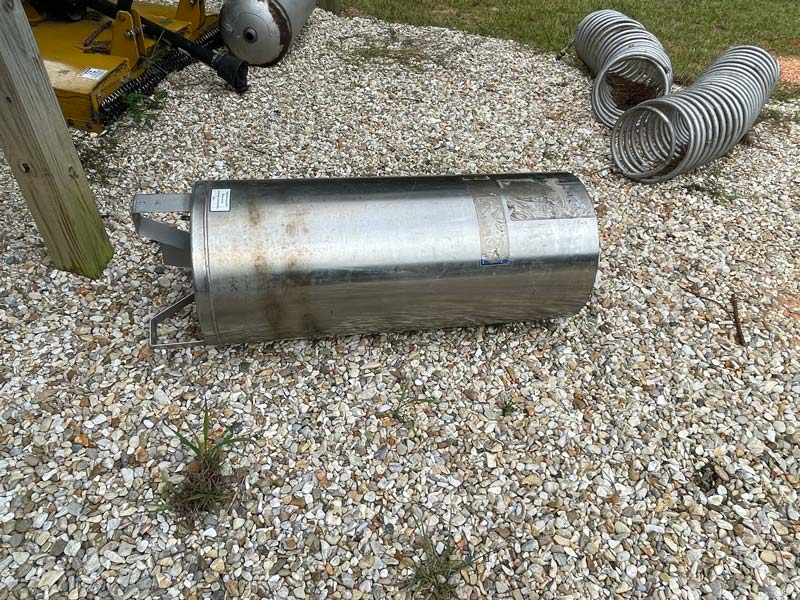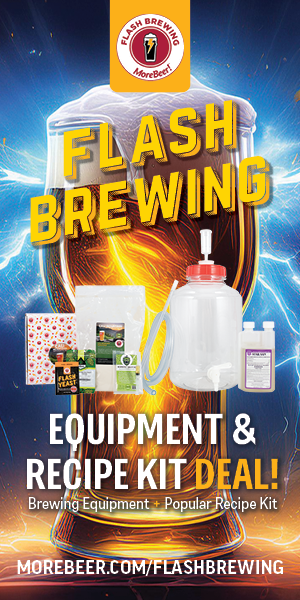A Kettle/Fermenter Conversion
Q: I recently was given an old stainless steel coke CO2 tank. This beast is able to withstand 300 psi and I’m guesstimating it will hold at least 30 gallons (114 L). I was hoping to make a brew kettle/fermenter combo out of it. I was planning on putting an 8-in. (20-cm) ferrule on each end with different size tri-clamp ports. are there any recommendations or designs out there to follow? How many heating element ports does it need to have? What’s the Best way to cool wort/temperature control? I was hoping to have a design before I started cutting this thing up and ruining it.
— Kevin Ricks • Macomb, Mississippi
A: Wow, this is a fun question and a fun project! Looking at the photos, it appears this vessel was insulated and covered by an outer jacket, essentially a second tank. The inner tank is perfect for a fermenter and the outer jacket, if that is indeed what your pictures show, will be great for a kettle. I will start by offering some ideas about the fermenter and then cover the kettle project.
For starters, your tank is a great example of a used vessel with some relevant documentation; it’s a real-deal, 300 psig-rated vessel carrying both an ASME stamp and CRN designation. Vessels that have this sort of data plate have been designed, built, and tested in accordance with the American Society of Mechanical Engineers requirements for pressure vessels (defined as vessels with working pressures greater than 15 psig or 1 atmosphere greater than atmospheric pressure). CRN stands for Canadian Registration Number and signifies that this tank also conforms with Canada’s Technical Standards and Safety Authority. Really a wonderful freebie!

An old, pressure-rated stainless steel CO2 tank and its outer jacket (see image below) is the starting point for one homebrewer’s DIY build. Photos courtesy of Kevin Ricks
Just for full disclosure, I am not an engineer, but I did work for a U.S. stainless steel design, engineering, and fabrication company from 1997 to 2016 and am not shooting from the hip with the ideas that follow. Fabrication projects need to be clear, so I am going to be concise with words.
Vessel Penetrations and Ferrules
Because you are starting with a stamped vessel, I strongly suggest finding a sanitary stainless welder who can make proper penetrations and weld ferrules on this vessel that conform to pressure vessel codes. The modifications will negate the original stamp, but so-called ASME R-stamps are used for vessel repairs that allow one to maintain the code. It’s definitely something to consider if you want to retain the value of that stamp.
Another thing to note before starting is the vessel alloy. Your tank is made using Type 201 stainless (you can see some numbers on the steel and part of those indicate alloy type), which is a lower-cost alternative to Type 304. Type 201 contains 15% chromium and 5% nickel, compared to 18% chromium and 8% nickel for Type 304 stainless. Your plan is to weld 8-in. (20-cm) ferrules to this vessel and most of those ferrules are made from Type 316L stainless steel. You need to make sure the welding wire used is compatible for T201 to T316L welds. Another reason to find a local welder to make the weld. That’s it for suggestions related to the pressure vessel itself.
In my opinion, insulation for small tanks can add more expense and time to install than it’s worth.
One related comment about welds; you should have the ferrule you soldered on the bottom of the second vessel, the one I assume to the outer jacket, removed and have it welded with the correct weld wire.
Bits and Bats
For your fermenter project, you will need a way to fill, empty, vent and pressurize the headspace, measure and control temperature, draw samples, add dry hops, and clean the fermenter after use. You can do all of these things with (1) 1.5-in. (3.8-cm) ferrule welded to the bottom of the tank, (1) 8-in. (20-cm) ferrule welded to the top of the tank, the addition of legs, an instrument for temperature monitoring and control, a handful of purchased parts, and some more welding not associated with the tank. You can also use an 8-in. (20-cm) ferrule on the bottom of the vessel if you want to, but this is not necessary to make a functional fermenter.
Here is a suggested list of purchased parts:
- (1) 8-in. (20-cm) tri-clamp blind cap, gasket, and clamp to serve as a “top plate” for the fermenter. Commercial fermenters in the 10,000 gallon/40,000 L+ size category oftentimes use so-called top plates to consolidate all valves, instruments, special fittings, etc. on a single chunk of stainless steel that is connected to a single flange installed on the top of the vessel. This makes fabrication much easier. Turns out this method is also very handy for small vessels because the 8-in. (20-cm) ferrule is large enough to reach inside of the vessel for welding and grinding.(1) 8-in. (20-cm) tri-clamp blind cap, gasket, and clamp to serve as a “bottom plate” for the fermenter.
- (1) Stainless immersion coil — I suggest buying this because bending stainless coils is not an easy task without special tools. The easiest way to install is to weld it into the top plate. Make sure your welder does not go crazy with the power and burn through your coil. You may want to use a small weld to attach a sleeve to the OD of the inlet and outlet connections on the coil to provide thicker material to weld to the top plate.
- (5) 1.5-in. (3.8-cm) tri-clamp ferrules, gaskets, and clamps.
- (2) 1.5-in. (3.8-cm) tri-clamp blind caps.
- (1) ½-in. (13-mm) tri-clamp ferrule, gasket, and clamp.
- (1) Spunding valve with 1.5-in. (3.8-cm) tri-clamp ferrule.
- (1) CIP (clean-in-place) tube and spray ball.
- (1) Racking line.
- (2) 1.5-in. (3.8-cm) tri-clamp butterfly valves for tank bottom.
- (1) Sample valve with 1.5-in. (3.8-cm) tri-clamp ferrule to attach to racking valve when samples are taken (not required, but a nice feature).
- (1) Connection for whatever is chosen for temperature measurement and control. A thermowell in the side of the tank is really the best design, but is not cheap. There are several solutions for this.
Grinding/Polishing
A key step to producing sanitary welds is removal of heat tint and/or weld grinding, a.k.a. polishing. This is a separate skill set from welding; not all welders are good grinders and good grinders are often not very good at welding. But a good grinder can make a poor welder look awesome! For your project, you want to find someone who can weld and grind.
Proposed Design Compared to Commercial Fermenters
The main differences with the proposed design compared to commercial fermenters are: 1) The lack of insulation and outer jacket encasing the insulation, and 2) External heat transfer. This proposed design uses an internal cooling coil and has no insulation. This may sound like an incomplete design but it’s a common type of fermenter used in very large beer fermenters that were designed and built up until the early 1970s. I am suggesting this for your project because it is the easiest way to retrofit your pressure vessel for use as a sweet little beer fermenter.
In my opinion, insulation for small tanks can add more expense and time to install than it’s worth. Most beers ferment in the 50–77 °F (10–25 °C) range in a room that is usually somewhere around 68 °F (20 °C). No insulation really required, even in commercial operations (check out the total lack of insulation on most wine tanks). When beer temperature is lowered for cold-aging at about 32 °F (0 °C), uninsulated tanks will sweat and gain heat from the environment. This may or may not be a big deal to you; if it is, consider using a temporary wrap.
Kettle Aspect
The kettle project is much easier and it looks like you are off to a great start. The main design question relates to the heating method and knowing the heating requirement will help guide how you go about heating your kettle. For the sake of discussion, let’s assume your kettle is large enough to hold 30 gallons (114 L) of liquid. You need headspace in your kettle and can probably safely begin the boil with about 24 gallons (90 L) of wort; that’s about how much wort your fermenter can hold without having too much foam blowing out during fermentation.

Kettles are typically designed to evaporate 5–10% per hour, so let’s err on the high side and size the heater to evaporate 10% or 2.4 gallons/9.1 L (20 lbs./9.1 kg) of water per hour. This is where the English system is easier than metric for quick calculations because ~1,000 BTUs is the energy required to convert 1 lb. (0.45 kg) of water from liquid to vapor. Therefore, you need to supply ~20,000 BTUs/hour to your kettle plus a bit extra to make up for losses and inefficiencies. Sticking with high-level math, let’s make this simple by oversizing the element by 25% for a total of 25,000 BTU/hr.
Time to do some parts shopping. Let’s first look for immersion coils powered by 220 volts. Heating elements are typically rated by wattage at some voltage; 25,000 BTU/hr. is equal to 7,327 watts. Skipping the shopping details, this is a fairly large power requirement and pushes this design above the range for home-type heaters. The good news is that this is a fairly common element and it is easy to find something large enough that is equipped with a tri-clamp ferrule. You should be able to find a good supply of elements in this range with 2-in. (5-cm) ferrules. The simplest installation for this will be to install a single ferrule on your kettle located a few inches above the bottom dish-to-shell weld seam. You can simply clamp the heating element into place, power it up, and you are good to go! Two key tips. The first is to make sure the element is covered with liquid before powering it up. And the second is to use either a rheostat or a type of switch that allows control of the heater. 7,500 watts at 220 volts equals 34 amps; not a small device.
I see that you have laid out a whirlpool nozzle on your kettle. While whirlpools are great brewing tools, they work best when the aspect ratio of the wort level is about 2–3 times wider than the wort depth. Your vessel puts the wort height at about 2 times greater than the width; far from the ideal wort level. Another very key design detail to a properly functioning whirlpool is either the absence of internals, like wort heaters, or unobtrusive and symmetrical internals, such as smooth-walled internal calandrias (shell and tube heaters that are installed vertically in large kettles). Not a big deal as long as you use something to either contain hops during the boil or something to strain hops from wort after the boil. And if you purge the bottom of your fermenter about 6–8 hours after filling you can easily remove any sediment that falls before the onset of fermentation.
My answer offers a few ideas of how you can approach your project. One thing I know about equipment design is that there are many great ways to boil wort, separate trub, and contain beer during fermentation that are as different as the beers we brewers like to brew. No single design is the hands-down winner and the best equipment designs provide brewers tools that can be safely and effectively used to brew a very wide range of beers. I look forward to seeing some pictures after your project is complete!



